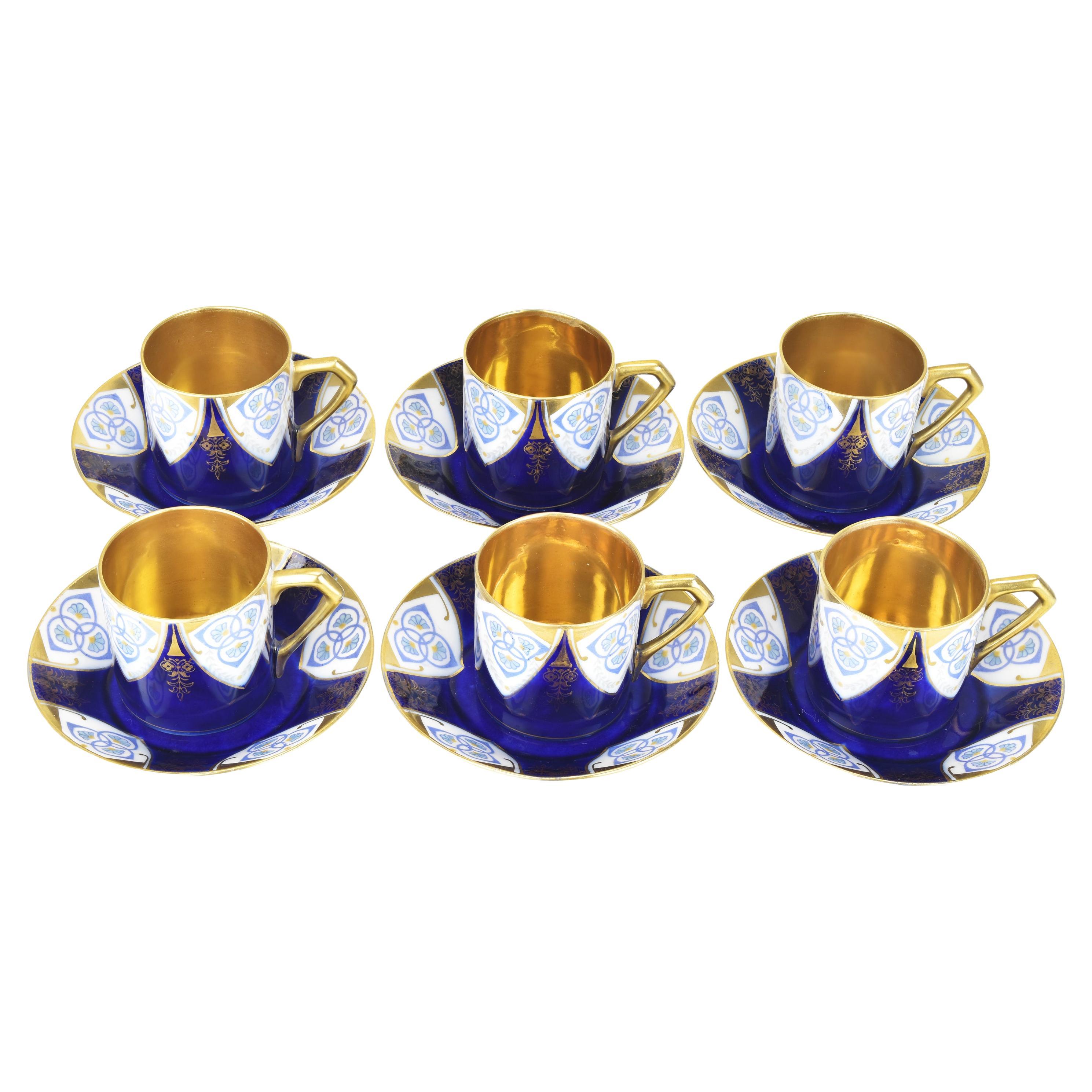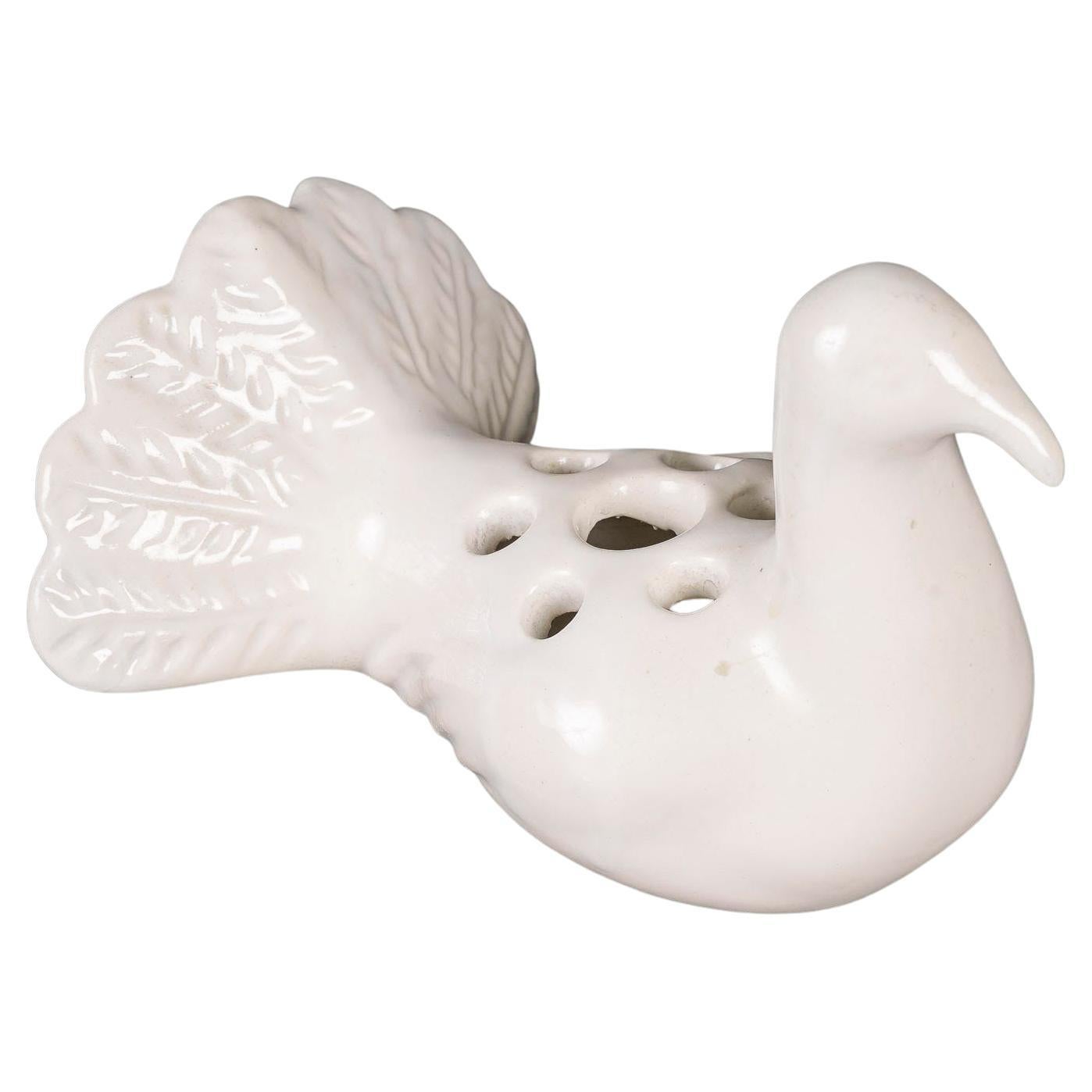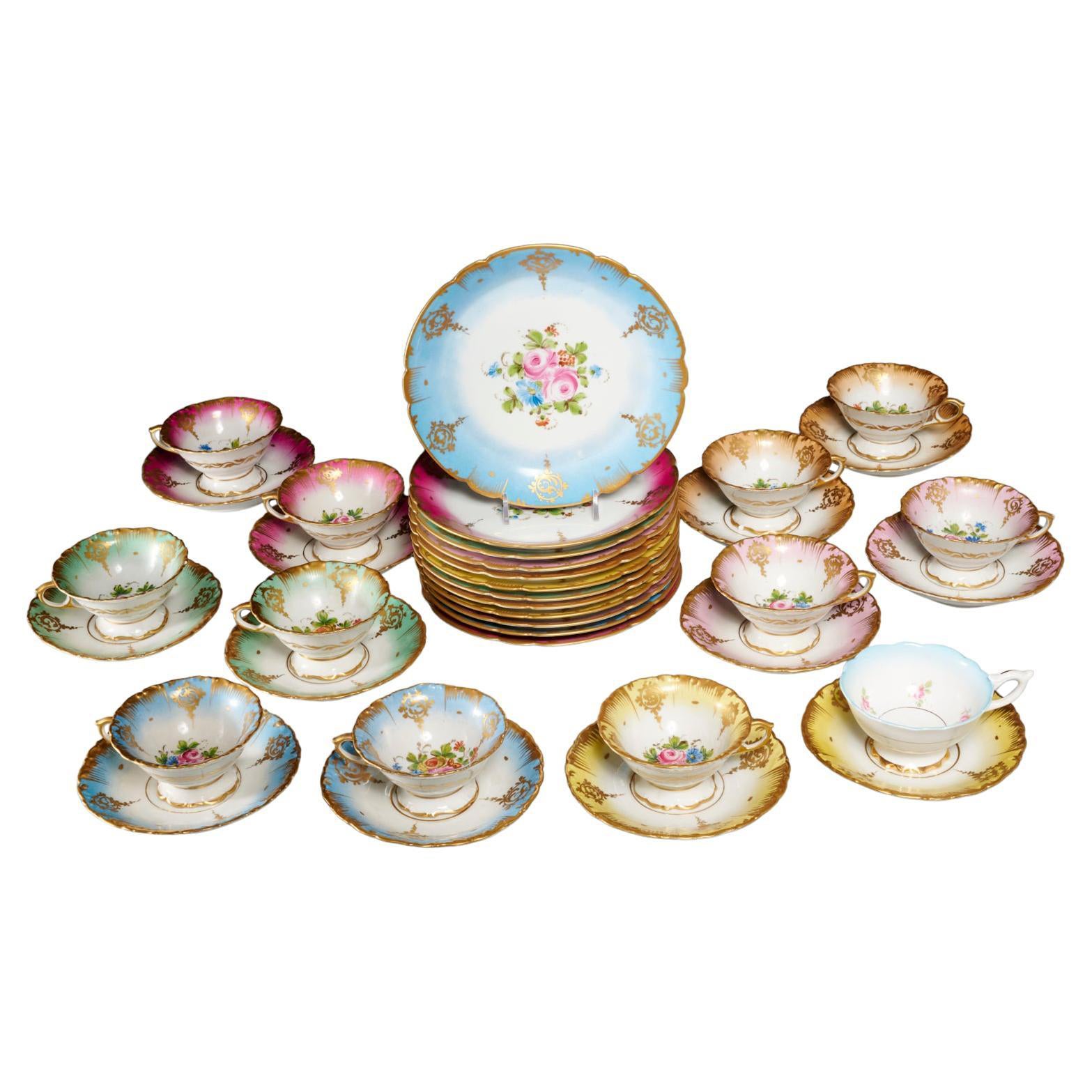Items Similar to Mocha Service - Six Cups - Sèvres Porcelain - Period: Art Nouveau
Want more images or videos?
Request additional images or videos from the seller
1 of 15
Mocha Service - Six Cups - Sèvres Porcelain - Period: Art Nouveau
About the Item
Charming mocha set in Sevres porcelain.
It consists of six cups and a tray in the shape of a "Horseshoe" in polychrome porcelain decorated with sprays of flowers and golden highlights.
Period : Art Nouveau
Dimensions: Tray in the shape of a "horseshoe" : Height : 1,8cm x 22,5 cm /20,5 cm
Cup: Height: 5cm x width with handle: 5cm
Did you know that it was only in the 19th century that coffee became a common drink that was no longer reserved for the elite alone?
The change in "status" of this drink has an impact in the art world.
The coffee is more and more drawn by painters in their canvas as a daily drink accompanying the population in different scenes of life.
In France, "Moka" refers to coffees that have passed through the Yemeni port of Moccha, from where the first coffee beans left in the 17th century.
But for coffee specialists, mocha refers to a coffee endemic to Ethiopia, of the Arabica variety.
- Dimensions:Height: 1.97 in (5 cm)Diameter: 1.97 in (5 cm)
- Sold As:Set of 7
- Style:Art Nouveau (In the Style Of)
- Materials and Techniques:
- Place of Origin:
- Period:
- Date of Manufacture:19th Century
- Condition:
- Seller Location:CRÉTEIL, FR
- Reference Number:1stDibs: LU7814234713932
About the Seller
4.0
Vetted Seller
These experienced sellers undergo a comprehensive evaluation by our team of in-house experts.
1stDibs seller since 2022
9 sales on 1stDibs
Typical response time: Several days
- ShippingRetrieving quote...Ships From: CRÉTEIL, France
- Return PolicyA return for this item may be initiated within 14 days of delivery.
More From This SellerView All
- Canton Polychrome Porcelain Circular Cup, Period, Mid-19th CenturyLocated in CRÉTEIL, FRLovely polychrome porcelain bowl from Canton. We find on this Canton porcelain the characteristic decoration painted on a white background representing large polylobed medallions or cartridges alternating palace scenes and nature decorations with motifs of birds, plants, flowers, and butterflies. Period: Mid-19th Century Dimensions: diameter 20cm Solid and fairly excavated funds use gold. The artist painter uses the circular shape of the object to represent the scenes continuously. Here we find the Chinese characters in a palace, surrounded by friezes of flowers. The colors remain vivid, especially with light greens and pinks. In the second half of the 19th century, when Japan established itself as a source of artistic inspiration, and the image of China and its inhabitants tarnished, several Chinese porcelain collections...Category
Antique 19th Century Asian Porcelain
MaterialsPorcelain
- Pair Of Bookends - Lalouvière Enamels - Polychrome Porcelain - Period: 20thLocated in CRÉTEIL, FRA delightful pair of polychrome porcelain bookends, Louvière enamels, decorated with kneeling young women with garçonne hairstyles. Period : XXth Century - Art Déco Dimensions: Heig...Category
20th Century Belgian Art Deco Porcelain
MaterialsPorcelain
- Brule Parfum - China - Quing Dynasty - Glazed Porcelain Stoneware - Period: 19thLocated in CRÉTEIL, FRMagnificent Chinese perfume burner in porcelain stoneware with turquoise glaze. Very fine work from the Qing Dynasty, in the Ming style, with its shape...Category
Antique 19th Century Chinese Chinoiserie Porcelain
MaterialsPorcelain
- Service 45 Pieces Limoges, Signed Lp Decorated Reserved Nanjing, The DignitariLocated in CRÉTEIL, FRDelightful vintage French service in Limoges Porcelain, collection "Les dignitaires d'Asie" signed LP Décoré Réservé Nankin, 20th Century, this magnific...Category
20th Century Asian Porcelain
MaterialsPorcelain
- Blown Glass Ewer - Murano - Art Nouveau - Period: Early 20th CenturyLocated in CRÉTEIL, FRBeautiful ewer in white Murano glass, blue and red watermarked, mouth-blown. Until the 17th and 18th centuries, ewers were used to serve drinks. Generally made of gold or silver precious metal, finely sculpted and chased, it takes the form of an elegantly shaped vase, generally taller than it is wide, mounted on a foot, with a spout and handle. Its name comes from the word aigue, meaning water in Old French (as does the locality of Aigues-Mortes). The ewer was widely used throughout the Middle Ages and the Renaissance. In the 18th century, it was replaced by the crystal carafe and the earthenware water jug. The water jug was originally designed to serve water on tables. It was also used for washing. Period: Early 20th century Dimensions: Height: 33cm - Width: 16cm Filigree glass is the French translation of the old Venetian term "vetro a filigrana"; this name covers a range of transparent blown glass varieties in which stretched glass threads ("canne") in white or various colors are incorporated. "Latticino" or "Latticinio" is an Italian term that has fallen into disuse and also designates "vetro a filigrana". This generic term covers three different types of decor: "vetro a fili", in which the "canes" form parallel lines; "vetro a retorti...Category
20th Century Italian Art Nouveau Glass
MaterialsGlass
- Large Laughing Buddha Statue - Green Hard Stone - China - Period: Art NouveauLocated in CRÉTEIL, FRVery nice realization in green hard stone made in China. This large statue depicts the standing "Laughing Buddha" wearing a necklace of pearls of wisdom in his left hand and a ball in his right hand known as the ball of wealth. A large solar disc, symbolizing light, illuminates the Buddha's smile. The meaning of the laughing Buddha with beads and/or a ball of wealth is that of meditation. The representation of the wealth ball is a sign of wealth and prosperity. Period: Late 19th century - Early 20th century - Art Nouveau Dimensions: Height: 103,5cm x Width: 30cm x Depth: 18cm The image of the Laughing Buddha is inspired by a wandering Chinese monk, Budai (Hotei, in Japanese), who lived there centuries ago and believed to be Maitreya, or the Buddha to come. The plump figure and the benevolent attitude of the statue suggest contentment, magnanimity and plenitude. Often referred to as the Laughing Buddha, his signature smile symbolizes contentment and pure joy. The Laughing Buddha is considered a symbol of good luck, and rubbing its big head or belly is believed to bring good fortune and wealth. The fat belly of the Laughing Buddha is a symbol of tolerance, it also shows that prosperity and wealth can go hand in hand with enlightened consciousness. If we talk about Hinduism, Lord Kuber is considered as the Lord of Wealth and Fortune. However, in China, people used to keep a Laughing Buddha statue...Category
Antique Late 19th Century Chinese Art Nouveau Figurative Sculptures
MaterialsStone
You May Also Like
- Set of 6 Mocha Cups w. Saucers Cobalt Blue Gold Painted Art Nouveau SecessionistBy Joseph Maria OlbrichLocated in Bad Säckingen, DEThis set is made of fine white porcelain, and each cup and saucer is decorated with a unique secessionist pattern which reminds on designs by Joseph Maria Olbrich. The pattern featu...Category
Antique 1890s Austrian Art Nouveau Porcelain
MaterialsPorcelain
- Art Nouveau Villeroy and Boch Saxony Poppy Porcelain Egg CupsBy Villeroy & BochLocated in New York, NYSet of four Jugendstil Saxony Poppy porcelain egg cups by Villeroy and Boch, Dresden, Germany, dating between 1874- 1909. Beautiful stylized Art No...Category
Antique Late 19th Century German Art Nouveau Porcelain
MaterialsPorcelain
- Six Rococo Sèvres Style Porcelain PlatesBy Manufacture Nationale de SèvresLocated in London, GBEach porcelain plate in this set of six features a navy-blue ground, distinctive to works produced in the style of Sèvres, and gilded rims with ornate patterns inscribed. The centre ...Category
Antique 19th Century French Rococo Porcelain
MaterialsPorcelain
- White Porcelain Brush Display, 20th Century, Art Nouveau Period.Located in Saint-Ouen, FRWhite Porcelain Brush Display, 20th Century, Art Nouveau period. Brush display stand for storing brushes after or during the painting of a picture, early 20th century white porcelai...Category
Early 20th Century French Art Nouveau Porcelain
MaterialsPorcelain
- Sèvres Style Gilt and Painted Porcelain Dessert Service for 12By Manufacture Nationale de SèvresLocated in Morristown, NJ20th c., France, gilt and painted porcelain dessert service. The set is decorated with pink rose clusters on various color grounds and gold accented scall...Category
20th Century French Art Nouveau Porcelain
MaterialsGold
- Sevres Porcelain Trembleuse Cup and Saucer First SizeBy Manufacture Nationale de SèvresLocated in Tunbridge Wells, GBHeading : 18th Century Sevres 1st Size Trembleuse Cup and Saucer Date : Late 18th Century c1790 Marks : Interlaced L mark in blue. Incised OO mark on b...Category
Antique 1790s French Porcelain
MaterialsPorcelain
Recently Viewed
View AllMore Ways To Browse
Fornasetti Calendar 1990
Hermes Bleus D Ailleurs
Hutschenreuther Blue Onion
Limoges Haviland Rare Plates
Meissen Hen
Paragon Double Warrant
Retro Coalport Bone China
Rosenthal Pierrot
Royal Copenhagen Girl With Goose
Royal Crown Derby W E J Dean
Royal Worcester Lizard
Versace Place Setting
Victoria Carlsbad Porcelain
Victoria Carlsbad
Vohenstrauss Johann Seltmann
Wedgwood American Clipper
Al Versace
Antique Porcelain Santa Claus





